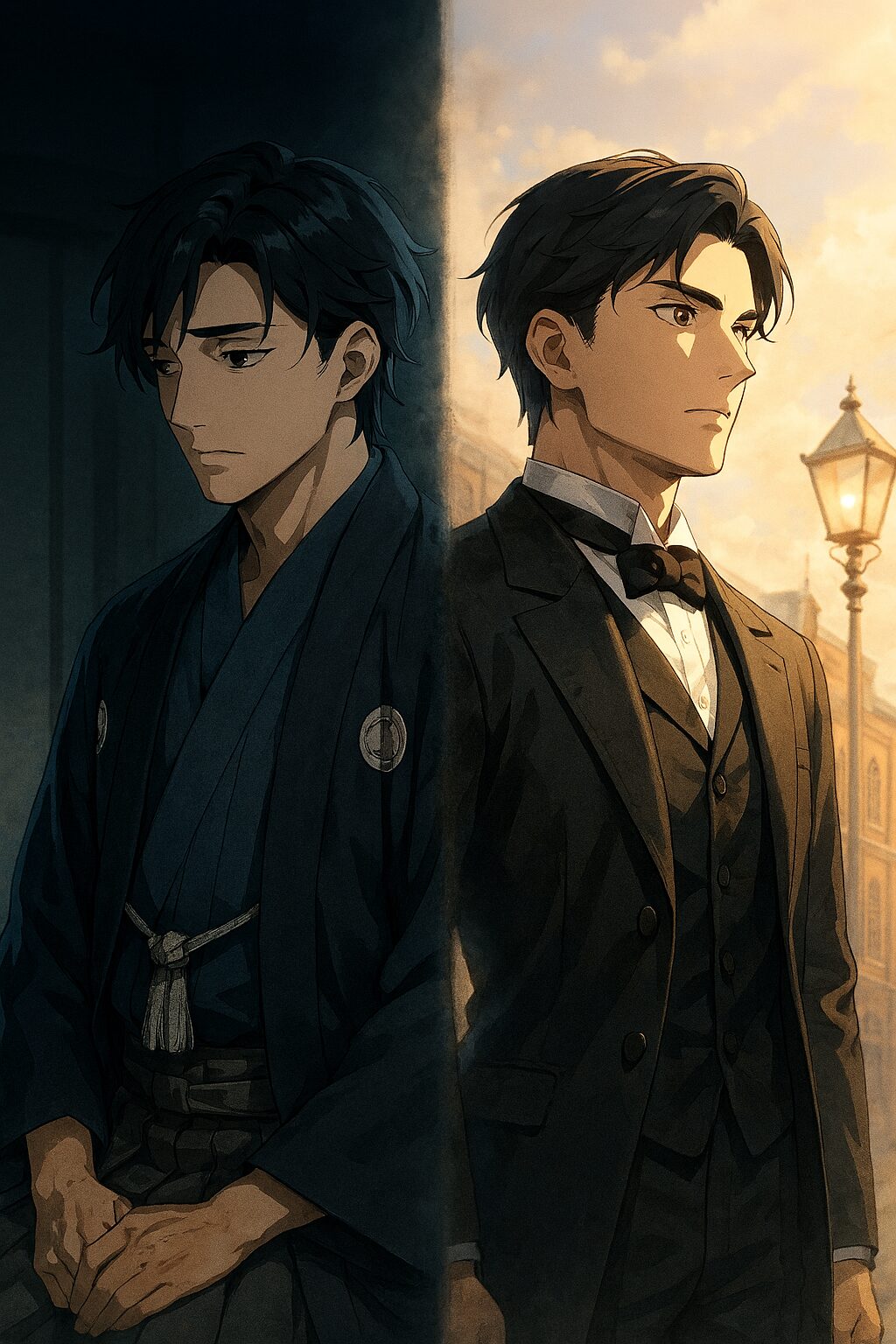Do you know what day November 12th is in Japan?
It is known as “Yōfuku Kinenbi” (洋服記念日), or “Western Clothing Day.”
In modern Japan, “Yōfuku” (Western-style clothing) like suits, T-shirts, and jeans are an obvious part of daily life. However, just 150 years ago, the people of this nation wore “Wafuku” (和服) —that is, kimono and hakama—as their everyday attire.
So, when and how did the Japanese encounter Western clothing and decide to adopt it? November 12th is a highly symbolic day in Japan’s modernization, marking the “official start” of this seismic shift.
The Origin of Western Clothing Day: The “Uniform” of Modernization
This anniversary dates back to November 12, 1872 (the 5th year of the Meiji Era).
On this day, the Meiji government issued “Dajōkan Proclamation No. 339,” which decreed the “official uniform for government officials.” This is commonly known as the “Fukusōrei” (服装令), or the Clothing Edict.
Specifically, it stipulated that the nobility (Kazoku) and government officials (Kanri) must wear Yōfuku (such as a frock coat) as their formal ceremonial attire.
Why “Western Clothes”?
To understand this, we must understand the context of 1872.
Japan had just ended the 250-year rule of the samurai (the Edo Shogunate) and established a new government centered on Emperor Meiji. This was the peak of the “Meiji Restoration” (明治維新).
As Western powers advanced into Asia, Japan was desperate to maintain its independence. To do so, it began to absorb Western technology, law, military systems, and culture at a ferocious pace. This movement was called “Bunmei Kaika” (文明開化), or “Civilization and Enlightenment.”
1. Yōfuku Was the Mark of a “Civilized Nation”
To the Western powers of the time, Japanese customs like the kimono and the “chonmage” (topknot) hairstyle were seen as “uncivilized.”
For Japan to be recognized as an equal, “civilized” nation—and to revise the unequal treaties forced upon it in the late Edo period—it needed to first align its “appearance” with the Western standard.
Western clothing, especially frock coats and military uniforms, became an international “passport” and a “battle uniform” for diplomacy. When Emperor Meiji himself cut his topknot and donned a Western uniform, it was a powerful statement of national resolve.
2. Yōfuku as a Symbol of “Efficiency”
The kimono is a magnificent garment, deeply rooted in Japan’s climate and aesthetics. However, with its complex obi (sash) and long sleeves, it was impractical for factory work, rapid military maneuvers, or sitting in a chair for desk work.
Functional and active “Yōfuku” was the very emblem of the nation’s goals: “Fukoku Kyōhei” (Enrich the country, strengthen the military) and “Shokusan Kōgyō” (Promote new industries).
A Deeper Look: “Wakon Yōsai” and the Culture of “Switching”
This “Western Clothing Day” is not just a fashion anniversary. It is a key to understanding one of the most important characteristics of Japanese culture: “Wakon Yōsai” (和魂洋才).
This slogan means “Japanese Spirit, Western Technology.”
The Japanese did not accept Yōfuku as a *replacement* for Wafuku. They accepted it as an entirely *new category* of clothing.
1. The Dual Structure of Public and Private
Initially, the Clothing Edict was only for the elite—officials and nobles. Commoners continued to live their lives in Wafuku.
However, as the elite began to wear Yōfuku as their “public” or “work” attire, a clear boundary emerged:
- Yōfuku (Western Clothes): Attire for work, school, the military, and public-facing situations. (The “Tatemae” or public facade).
- Wafuku (Japanese Clothes): Attire for relaxing at home, festivals, and traditional ceremonies. (The “Honne” or private self).
This “switching” (tsukaiwake) remains strong in Japan today.
A “salaryman” who wears a suit all week might relax at home in a “Jinbei” or “Yukata” on the weekend. A student who wears jeans every day will wear a formal Kimono or Hakama for their coming-of-age ceremony or university graduation.
This is the coexistence of “Wa” and “Yō” that began on November 12th. It is a perfect expression of the Japanese delineation between the public and private self.
2. The “Japanization” of Western Clothes
Japan did not just adopt Yōfuku; it sublimated it into its own unique culture.
The “suit,” introduced in the Meiji era, became the “uniform of the salaryman” during the post-war economic boom. It became a symbol of group identity and diligence, traded for the loss of individuality.
Furthermore, Japanese school uniforms (the “Sailor-fuku” and “Gakuran”) were originally based on Western military and sailor uniforms. Today, however, they are famous worldwide as symbols of “Japanese student culture” through anime and manga.
Japan excels at taking foreign culture (Yōsai) and reinterpreting it within its own context (Wakon) to create new value.
What November 12th Asks Us
“Western Clothing Day” commemorates a major decision Japan made over 150 years ago, staking its very survival on the outcome.
Clothing is not just fabric to cover the body. It is personal identity, a cultural symbol, and sometimes, a national strategy.
Japan succeeded in acquiring the “functionality” of Western clothing while protecting the beautiful “tradition” of Japanese clothing, forging its own unique path in the world.
What do you think after reading this?
In your country, are there new “uniforms” or “standards” that were born from adopting a foreign culture?
If you had to appear in a “public” setting in a completely different culture, would you actively adopt the local attire, or would you express your identity by wearing your home country’s traditional clothing?
External Links
- Modern Japan: Images from the 19th Century (National Diet Library) (English resource showing the clothing changes of the Meiji era.)
Internal Links
- Category: What’s Today’s Special Day Series?
11月12日は洋服記念日:日本が「スーツ」を選んだ日
11月12日。この日が何の日かご存知でしょうか。
日本では「洋服記念日」として知られています。
現代の日本では、スーツやTシャツ、ジーンズといった「洋服」は当たり前の存在です。しかし、ほんの150年ほど前まで、この国の人々は「和服(Wafuku)」、すなわち着物や袴(はかま)を日常的に身に着けていました。
では、いつ、どのようにして日本人は洋服と出会い、それを受け入れたのでしょうか。11月12日は、その「公式な始まり」を告げた、日本の近代化における極めて象徴的な一日なのです。
洋服記念日の由来:文明開化の「制服」
この記念日は、1872年(明治5年)11月12日にまで遡ります。
この日、明治政府は「太政官布告第339号」として、「官吏(かんり)の制服を定める」という布告を出しました。これが通称「服装令(ふくそうれい)」と呼ばれるものです。
具体的には、「華族(皇族に次ぐ身分)および官吏は、大礼服(最も格式の高い儀式用の服)として洋服(フロックコートなど)を用いること」を定めたのです。
なぜ「洋服」だったのか?
1872年という時代背景を理解することが不可欠です。
当時の日本は、約250年続いたサムライの時代(江戸幕府)が終わり、明治天皇を中心とする新政府が発足したばかり。いわゆる「明治維新」の真っ只中にありました。
欧米列強がアジアに進出する中、日本は国家の独立を保つために、欧米の技術、法律、軍事、そして文化を猛烈なスピードで吸収しようとしました。これが「文明開化(ぶんめいかいか)」です。
1. 洋服は「文明国」の証だった
当時の欧米諸国にとって、着物や、髪を「ちょんまげ」に結うスタイルは、「未開の地」の風習に見えました。
日本が欧米と対等な「文明国」として見なされ、幕末に結ばされた不平等条約(ふびょうどうじょうやく)を改正するためには、まず「外見」から欧米のスタンダードに合わせる必要があったのです。
洋服、特にフロックコートや軍服は、国際社会における「パスポート」であり「戦闘服」でした。明治天皇自らがちょんまげを切り、洋装をまとったことは、国家としての強烈な決意表明でした。
2. 「効率」の象徴としての洋服
着物は日本の気候や美意識に根差した素晴らしい衣服です。しかし、帯を締め、袖を気にする必要のある着物は、工場での作業、軍隊での機敏な行動、椅子に座るデスクワークには不向きでした。
機能的で活動的な「洋服」は、日本が目指す「富国強兵(ふこくきょうへい)」(国を豊かにし、軍隊を強くすること)と「殖産興業(しょくさんこうぎょう)」(産業を育てること)の象EMBLEMでもあったのです。
日本文化の深層:「和魂洋才」と「使い分け」
この「洋服記念日」は、単なるファッショの記念日ではありません。これは、日本文化の最も重要な特性の一つである「和魂洋才(わこんようさい)」を読み解く鍵です。
「和魂洋才」とは、「日本の精神(和魂)を保持しつつ、西洋の技術や知識(洋才)を取り入れる」というスローガンです。
日本人は、洋服を「和服の代替品」として受け入れたのではありません。「新しいカテゴリー」として受け入れたのです。
1. 「ハレ」と「ケ」の二重構造
当初、服装令は役人や貴族など、一部のエリート層に向けられたものでした。一般庶民は依然として和服で生活していました。
しかし、エリート層が洋服を「公(おおやけ)の服」「仕事の服」として着用し始めると、徐々にその境界線が明確になっていきます。
- 洋服(Yōfuku):仕事、学校、軍隊、公の場での服装(=タテマエ、社会的な顔)
- 和服(Wafuku):家でのくつろぎ、祭り、伝統的な儀式での服装(=ホンネ、私的な顔)
この「使い分け」は、現代の日本にも色濃く残っています。
平日はスーツで働くサラリーマンが、週末は家で「甚平(じんべい)」や浴衣(ゆかた)を着てリラックスする。あるいは、普段はジーンズで過ごす学生が、成人式や卒業式では晴れ着(着物や袴)を着用する。
これこそが、11月12日に始まった「和(Wafuku)」と「洋(Yōfuku)」の共存の形であり、日本的な「公」と「私」の使い分けの表れなのです。
2. 洋服の「日本化」
日本人は、ただ洋服を受け入れただけではありません。それを独自の文化へと昇華させました。
明治時代に導入された「スーツ」は、戦後の高度経済成長期を経て、「サラリーマンの制服」として日本社会に完全に定着しました。没個性と引き換えに、集団への帰属意識と勤勉さを示すシンボルとなったのです。
また、学生服(セーラー服や学ラン)も、元々は西洋の軍服や水兵服がベースです。しかし、今やそれは「日本の学生文化」の象徴として、アニメや漫画を通じて世界に知られています。
日本は、外来の文化(洋才)を、自らの文脈(和魂)で再解釈し、新しい価値を生み出すことに長けているのです。
11月12日が私たちに問いかけるもの
「洋服記念日」は、150年以上前に日本が国家の存亡をかけて下した、大きな決断を記念する日です。
衣服は、単に体を覆う布ではありません。それは個人のアイデンティティ、文化の象徴、そして時には国家の戦略そのものです。
日本は、「和服」という美しい伝統を守りながら、「洋服」という機能性を手に入れ、世界の中で独自の地位を築きました。
この記事を読んだあなたは、どう思いますか?
あなたの国には、外国の文化を取り入れたことで生まれた、新しい「制服」や「スタンダード」はありますか?
もしあなたが、全く異なる文化圏で「公の場」に出る必要が生まれたとしたら、現地の服装を積極的に取り入れますか? それとも、自国の伝統的な服装でアイデンティティを示しますか?
外部リンク(External Links)
- Modern Japan: Images from the 19th Century (National Diet Library)
- 日本の国立国会図書館が所蔵する、明治時代の服装の変化を示す画像や解説(英語)。



コメント